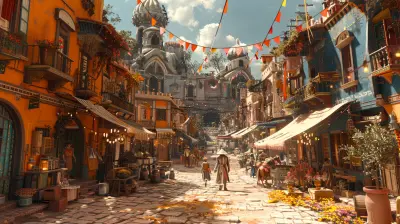How Free-to-Play Games Are Redefining Player Retention Strategies
31 August 2025
In the ever-evolving landscape of gaming, free-to-play (F2P) games have taken center stage and reshaped the way developers think about keeping players engaged. It's no secret that F2P games, like "Fortnite," "Genshin Impact," and "League of Legends," have become wildly successful. But how exactly do they retain players, and why are gamers so hooked?
Let’s dive into this topic to understand how F2P games are revolutionizing player retention strategies. Spoiler alert: It’s not just about the flashy graphics or endless updates—it’s about building a long-term relationship between the game and the player.
What Are Free-to-Play Games?
Let’s start with the basics. Free-to-play games are exactly what they sound like—games you can play without paying a penny upfront. That’s right, no initial cost, no upfront commitment.Sounds like a dream, right? Well, here’s the catch: most F2P games generate revenue through in-game purchases, cosmetic upgrades, or battle passes. But the beauty of it is that spending is (usually) optional. F2P games rely on their ability to keep players engaged long enough to convert their enjoyment into monetary investment, and that’s where player retention strategies come into play.
The Shift from One-Time Purchases to Ongoing Engagement
Remember the days when you’d just buy a game, play it, and move on to the next? Those days are slowly fading into history. Today, F2P games aren’t just trying to be memorable experiences—they aim to be a habit.Instead of offering a finite experience, these games deliver an infinite loop of challenges, rewards, and updates. They’re like a favorite TV show that keeps releasing new seasons just as you were about to consider watching something else.
But how do they pull it off? Let’s look at some key strategies.
1. The Power of Regular Updates
One of the biggest reasons F2P games have such strong retention is their ability to stay fresh. Developers are constantly rolling out updates, whether it’s new maps, characters, skins, or game modes.It’s like walking into your favorite bakery and finding a surprise new flavor every week—you just can’t resist coming back to check it out. Games like "Fortnite" are prime examples of this. With limited-time events, collaborations (hello, Marvel and Star Wars fans), and seasonal content, there’s always something to look forward to.
Takeaway? Keeping things fresh and dynamic keeps players hooked.
2. The Psychology of Rewards and Progression
Humans are wired to love rewards. Whether it’s leveling up, unlocking rare items, or earning in-game currency, F2P games know how to trigger that feel-good dopamine rush.These games often use a combination of:
- Daily Login Rewards: You log in, you get a reward—it’s that simple. But skipping a day? Well, that might mean missing out.
- Battle Pass Progression: Start the season with a clean slate and complete challenges to earn swag. It’s addictive, and you can see your progress right there on the screen.
- Loot Boxes or Gacha Mechanics: It's the thrill of opening a mystery box, hoping for a legendary item. It’s like unwrapping a birthday gift, but digital.
By dangling rewards just within the player’s reach, F2P games turn casual players into loyal ones.
3. Community Building and Social Play
Let’s be real—gaming is way more fun when you're not doing it alone. F2P games thrive on fostering communities through multiplayer modes, guilds, and co-op challenges.Think about it: would "Among Us" have blown up without the social dynamics of working with (or betraying) your friends? Probably not.
These games create shared experiences that make players feel like they’re part of something bigger. And the best part? If your friends are still playing, you’re less likely to quit—it’s like a digital peer pressure loop.
4. Personalized Player Experiences
Here’s where things get really smart. F2P games leverage data—lots of it—to understand their players. They know which levels you’re struggling with, how often you log in, and even what in-game items you like.This isn’t creepy—it’s genius. By tailoring the experience to your preferences, the game feels more like it was made just for you. It’s like walking into a coffee shop where the barista already knows your order.
Games like "Genshin Impact" use this to deliver events, quests, and rewards that align with how players behave, increasing engagement and, ultimately, retention.
5. The Free vs. Paid Balance
One of the most delicate dances F2P games perform is balancing free play and paid content. This is where many games succeed—or fail.Games that go too far with pay-to-win mechanics can alienate their player base, while those that offer everything for free risk not making enough money to stay afloat.
The key here is to make paid content feel optional yet desirable. A great example is the cosmetic skins in games like "Valorant" or "Apex Legends." They don’t affect gameplay, but they sure make you feel like a boss while playing.
6. Gamifying Life Through Events and Challenges
Who doesn’t love a challenge? F2P games are masters at introducing time-limited events and quests that give players something to work toward.These challenges are designed to fit seamlessly into your daily routine—it’s like checking off tasks on a to-do list but way more fun. Plus, the rewards at the end make the grind feel worth it.
Seasonal events, in particular, capitalize on FOMO (Fear of Missing Out). Didn’t participate in the Halloween event? Sorry, you missed that exclusive pumpkin skin. But hey, there’s always Christmas.
Why These Strategies Work
So, why are these approaches so successful? Because they tap into fundamental human psychology. F2P games aren’t just delivering entertainment; they’re creating habits, forming communities, and giving players a sense of progression and accomplishment.It’s not about holding your attention for a few hours; it’s about becoming your go-to way to relax, have fun, and connect with friends.
Are There Downsides?
Sure, F2P games aren’t perfect. Some critics argue that certain games manipulate players into spending money or exploit addictive behaviors. And let’s not forget those dreaded paywalls that can pop up, slowing down progression unless you fork over cash.But when done right, F2P games strike a balance that respects the player’s time and wallet while still delivering a compelling experience.
The Future of Player Retention in F2P Games
Looking ahead, the future of player retention in F2P games will only get more sophisticated. With advancements in AI and machine learning, games could become even better at personalizing experiences.Imagine a game that dynamically adjusts difficulty based on your skill level or introduces storylines tailored to your preferences. The possibilities are endless, and it’s all aimed at keeping players invested for the long haul.
More importantly, as the gaming community grows, so will the emphasis on creating inclusive, diverse spaces where everyone feels welcome. Because at the end of the day, games are about fun—and keeping players smiling is the ultimate retention strategy.
Final Thoughts
Free-to-play games have revolutionized the way we think about gaming. By focusing on engagement, community, and player satisfaction, they’ve redefined what it means to keep players coming back.It’s not just about launching a great game anymore; it’s about building a living, breathing ecosystem that players feel connected to. So, the next time you log into your favorite F2P game, take a moment to appreciate just how much thought went into making it a place where you want to spend your time.
The free-to-play model isn’t just changing games—it’s changing the way we play.
all images in this post were generated using AI tools
Category:
Free To Play GamesAuthor:

Lucy Ross
Discussion
rate this article
1 comments
Whitney Phelps
Great insights! Excited to see the future unfold!
September 6, 2025 at 4:13 AM

Lucy Ross
Thank you! I'm excited for what’s ahead too!


